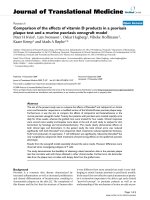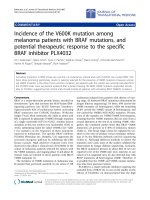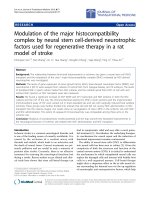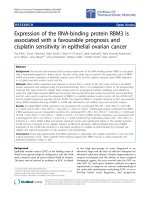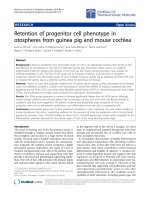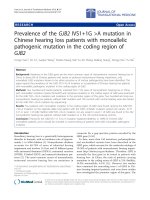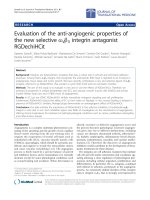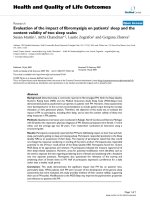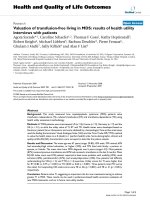Báo cáo hóa học: " Predictors of quality of life: A quantitative investigation of the stress-coping model in children with asthma" pptx
Bạn đang xem bản rút gọn của tài liệu. Xem và tải ngay bản đầy đủ của tài liệu tại đây (285.22 KB, 9 trang )
BioMed Central
Page 1 of 9
(page number not for citation purposes)
Health and Quality of Life Outcomes
Open Access
Research
Predictors of quality of life: A quantitative investigation of the
stress-coping model in children with asthma
Yvette Peeters*
1
, Sandra N Boersma
2
and Hendrik M Koopman
2
Address:
1
Medical Decision Making, University Medical Centre Leiden, PO Box 9600, 2300 RC Leiden, The Netherlands and
2
Medical Psychology,
University Medical Centre Leiden, PO Box 9555, 2300 RB Leiden, The Netherlands
Email: Yvette Peeters* - ; Sandra N Boersma - ; Hendrik M Koopman -
* Corresponding author
Abstract
Background: Aim of this study is to further explore predictors of health related quality of life in
children with asthma using factors derived from to the extended stress-coping model. While the
stress-coping model has often been used as a frame of reference in studying health related quality
of life in chronic illness, few have actually tested the model in children with asthma.
Method: In this survey study data were obtained by means of self-report questionnaires from
seventy-eight children with asthma and their parents. Based on data derived from these
questionnaires the constructs of the extended stress-coping model were assessed, using regression
analysis and path analysis.
Results: The results of both regression analysis and path analysis reveal tentative support for the
proposed relationships between predictors and health related quality of life in the stress-coping
model. Moreover, as indicated in the stress-coping model, HRQoL is only directly predicted by
coping. Both coping strategies 'emotional reaction' (significantly) and 'avoidance' are directly related
to HRQoL.
Conclusion: In children with asthma, the extended stress-coping model appears to be a useful
theoretical framework for understanding the impact of the illness on their quality of life.
Consequently, the factors suggested by this model should be taken into account when designing
optimal psychosocial-care interventions.
Background
Children with asthma have a lower health related quality
of life (HRQoL) than healthy children [1-3] and children
with severe asthma report an even lower HRQoL com-
pared to children with mild asthma [2]. Quality of life has
been defined as the individuals' perception of their posi-
tion in life in the context of the culture and value systems
in which they live, in relation to their goals, expectations,
standards and concerns [4]. Naturally health related qual-
ity of life stands for the quality of life in relation to one's
health. A better understanding of the different aspects of,
and influences on HRQoL is necessary to be able to offer
optimal psychosocial-care to children with asthma.
Stress and negative emotions of a chronic illness such as
asthma often result in anxiety, depression and anger
which affect HRQoL [5]. At the same time, coping-style
appears to be an important psychosocial moderator
Published: 26 March 2008
Health and Quality of Life Outcomes 2008, 6:24 doi:10.1186/1477-7525-6-24
Received: 6 December 2007
Accepted: 26 March 2008
This article is available from: />© 2008 Peeters et al; licensee BioMed Central Ltd.
This is an Open Access article distributed under the terms of the Creative Commons Attribution License ( />),
which permits unrestricted use, distribution, and reproduction in any medium, provided the original work is properly cited.
Health and Quality of Life Outcomes 2008, 6:24 />Page 2 of 9
(page number not for citation purposes)
between stress and negative emotions on the one hand,
and HRQoL on the other hand [6]. Individual differences
in coping with a chronic illness are described by several
theories of stress and emotion [7]. One of these theories is
the cognitive-appraisal model of Lazarus and Folkman
[8]. With their theory they show that a person confronted
with a stressor firstly evaluates this stressor and secondly
determines his or her emotional or behavioural reaction.
That is, the person evaluates whether there is potential
harm or benefit (primary appraisal) and consequently
decides what can be done to deal with the situation (sec-
ondary appraisal). An event is appraised as stressful when
primary appraisals exceed secondary appraisals, and by
using coping processes a person might be able to reduce
this stress [8].
Derived from this cognitive-appraisal model an extended
model for coping with a chronic disease was developed by
Maes, Leventhal and de Ridder [5]. Figure 1 shows this
extended stress-coping model. Based on the model, other
life events, disease characteristics, disease-related events,
and demographic characteristics are linked to the
appraisal of demands and goals. Furthermore, all factors
are directly or indirectly related to coping behaviour,
which itself is also moderated by external – and internal
resources. Finally, all these factors together contribute to
psychological, social and physical consequences
(HRQoL) trough coping.
To our knowledge only a few studies investigated the
extended stress-coping model in total [9-11]. In a sample
of adult heart patients, tentative proof was found for the
model in total [9,10]. Moreover, Röder et al. [11] investi-
gated this stress-coping model in children with asthma in
a school context. In their study three different disease-
related stressors were included: problems with school
work, shortness of breath and rejection by peers. It
appeared that all three stressors contributed to the expla-
nation of differences found in psychosocial functioning.
However, interrelations between the different factors in
the prediction of HRQoL remained unclear.
The aim of our study is to further explore predictors of
HRQoL with the stress-coping model resulting towards a
better understanding of HRQoL of children with asthma
in a general context.
Method
Participants and procedure
The sample for this study was obtained from the European
DISABility KIDS (DISABKIDS) project [12]. In the DISAB-
KIDS project, children with a chronic illness and their par-
ents were asked to participate in the study, while they
visited a paediatric hospital. After informed consent was
obtained, children and their parents were asked to fill in
self-reported questionnaires, which were handed out or
mailed [13]. After a 2–4 weeks interval parents and chil-
Stress-coping model of Maes, Leventhal & De Ridder (1996)Figure 1
Stress-coping model of Maes, Leventhal & De Ridder (1996).
Health and Quality of Life Outcomes 2008, 6:24 />Page 3 of 9
(page number not for citation purposes)
dren were asked to fill in another questionnaire. This
questionnaire was similar to the first except for an addi-
tional coping questionnaire and without questions about
demographic characteristics. For the present study, only
the children with asthma from Austria, Germany, Sweden
and The Netherlands were selected since in these coun-
tries the same HRQoL questionnaire was elected during
re-test. The ethics review committee of the different paedi-
atric hospitals approved the research protocol.
Instruments and measures
The constructs of the stress-coping model were assessed
with a selection of all questionnaires developed specifi-
cally for the DISABKIDS project [14]. For 'demographic
characteristics', age of the child at time of participation,
educational level of the parents and living environment
were selected. 'Education of the parents' reflects the high-
est completed education of the parent who filled out the
questionnaire. 'Living environment' was rated by the par-
ent according to three categories: village, small town or
big city.
In the questionnaires administered in the DISABKIDS
asthma module four additional questions answered by
the parent about the treatment of their child's asthma like
"Did your child visit a specialist in the last 12 months?"
were asked. To assess 'treatment characteristics' an index
was created based on these four questions. In addition,
children were asked whether they use medicine or not.
Based on questionnaires only answered by the parents,
'asthma severity', 'social support' and 'internal resources'
were assessed. Since asthma is subject to change on a daily
basis there is no standard way to score the severity of
asthma [14]. However, in the DISABKIDS project 'asthma
severity' was based on the scale of Rosier et al. [15], a ques-
tionnaire consisting of six questions answered by a four
point Likert scale, ranging from 0 (never) to 4 (daily). The
score on this questionnaire was categorised in low, mild,
moderate or severe asthma. 'Social support' was measured
by the single item, single or two parent families and by
three questions about the accessibility of social support.
Scores on the questions about accessibility of social sup-
port were weighted and totalled. Finally to indicate 'inter-
nal resources', overall development on a 3 point likert-
scale, and occurrence of physical, emotional or social
problems of the child was rated. Based four questions
answered by the parent about the treatment of their
child's asthma like "Did your child visit a specialist in the
last 12 months?" on the answers an index for 'internal
resources' was created.
Some questionnaires only answered by the children, were
used to assess appraisal of demands and goals, coping
behaviour and HRQoL. To assess 'appraisal of demands
and goals' the domain limitations from the DISABKIDS
Chronic Generic Measure (DCGM-37) [14] was used. If
children experience limitations they will have difficulties
with a particular event and with pursuing their goals.
'Coping' was assessed with the COping with a DIsease
(CODI) questionnaire [16], a coping questionnaire which
includes six coping strategies: acceptance, avoidance, cog-
nitive-palliative, distance, emotional reaction and wishful
thinking. Finally the 12 item DISABKIDS-Smiley's [14]
was answered to assess HQoL. This scale is associated with
other measures of HRQoL like, the revised children qual-
ity of life questionnaire (KINDL) [17], and discriminates
between different levels of clinical severity [14]. In Figure
2 an overview is given of which indicators were used to
assess the different constructs of the stress-coping model.
Data analysis
Prior to the analyses, all variables were examined for
multi- and univariate outliers, missing values, normality,
and linearity. Missing data were excluded list-wise. Pear-
son correlations were used to examine the associations
between the variables, followed by different regression
analyses to explore possible multivariate associations. A
path analysis was conducted to test the fit of our data on
the specified model (Figure 3). A good fit is indicated by a
non-significant chi squared statistic, a Comparative Fit
Index [CFI] < 1.0, a Bentler-Bonett Non-normed fit index
[NNFI] < 0.95 and by a Root mean-square error of approx-
imation [RMSEA] < 0.05.
Results
From the 280 eligible children, 193 were not included in
the re-test. The re-test was conducted by the DISABKIDS
project to investigate the reliability of their question-
naires. However only in this re-test a coping questionnaire
was added. For this reason exclusively data from children
selected in the re-test could be included. The final sample
of this study comprised 34 girls and 53 boys, between 7
and 16 years old. As judged by their parents, 5 children
had severe, 15 moderate, 19 mild and 45 low severe
asthma; data of 3 children were missing. Sixty-nine (79%)
of all questionnaires answered by a parent was answered
by the mother.
One univariate outlier and four cases with missing values
on more then three variables were identified and
removed. Normal distributions of and linearity between
all variables in the study were found to be satisfactory
except for one of the subscales of the CODI the variable
'wishful thinking' (Skewness = -1.574 with SD. = 0.257;
Kurtosis = 1.909 with SD. = 0.508). This variable was
therefore not included in further analyses.
All instruments revealed a satisfactory reliability with
Cronbachs' alphas between 0.69 and 0.84. As a guideline,
Health and Quality of Life Outcomes 2008, 6:24 />Page 4 of 9
(page number not for citation purposes)
Cronbach alpha values of 0.7 are regarded as satisfactory
applying scales to further analysis [18]. The instrument
used to measure 'treatment characteristics', including four
questions about the treatment of the child answered by
the parent, revealed a relatively low Cronbachs' alpha.
However, the items in this questionnaire are not necessar-
ily related to each other. That is, asthma treated with med-
ication prescribed by a physician is not necessary related
to self medication. In the construction of the DISABKIDS
instruments three age groups were used, 4–7 years, 8–12
years and 13–16 years [16]. Yet, in this study 'age' was
dichotomised into younger and older than 12 years, since
only one child was younger than 8 years.
Univariate relationships
Table 1 shows the Pearson correlation coefficients and lev-
els of significance, of possible correlates of 'appraisal of
demands and goals' which is represented by the variable
'limitations'.
Table 2 shows the Pearson correlation coefficients
between possible correlates of and the six coping scales.
Only 'Limitations', was significantly correlated with all
coping scales except for 'cognitive-palliative coping'. The
variable 'development of the child' was significantly
related to the coping scale 'emotional reaction'.
Table 3 shows that only the coping scales 'acceptance' and
'emotional reaction' were significantly correlated with
HRQoL.
Testing the model
Since there were too many variables compared to our sam-
ple size, to test the model, a selection of the variables had
to be made. Treatment variables answered by the parents
appeared to have a slightly higher correlation with limita-
tions than those answered by the children. Moreover, in
general variables answered by parents tend to be more
reliable [19]. In further analyses answers given by the par-
ents were therefore used to assess 'treatment characteris-
tics'. With respect to the different coping variables, no
more than two variables could be included. Both the var-
iable 'avoidance' and 'emotional reaction' were selected;
the variable 'acceptance' was excluded due to a significant
multivariate kurtosis.
The model that follows from this selection, with three
demographic variables and two external resources,
showed a poor fit. Including the demographic variables
and 'external resources' one by one, however, revealed a
model with a good fit (Chi square (24,70) = 28.012, p =
Stress-coping model with Instruments and MeasuresFigure 2
Stress-coping model with Instruments and Measures.
External Resources
Disease Characteristics
HRQoL
One or two parent families
Severity according to parents
Appr aisal of
demands and goals
Accessibility of social support parents
Treatment Char acteristics
Treatment Characteristics according to the parents
Demographic Char acter istics
Treatment Characteristics according to the child
Living environment
Age of the child
Education parents
Limitations
Coping
DISABKIDS-
Smiley’s
CODI
Internal r esour ces
Development of child according to parent
Table 1: Pearson correlations (n) between predictors and
limitations.
Limitations
Severity (parent) .510** (81)
Treatment (parent) 307** (78)
Treatment (child) 285* (80)
Education of Parent 151 (80)
Living Environment 134 (80)
Age 023 (81)
* p < .05, ** p < .01
Health and Quality of Life Outcomes 2008, 6:24 />Page 5 of 9
(page number not for citation purposes)
0.259; Comparative Fit Index [CFI] = 0.943; Bentler-
Bonett Non-normed fit index [NNFI] = 0.914; Root mean-
square error of approximation [RMSEA] = 0.049). Within
this model, 'age of the child', 'living environment' and
'accessibility of social support by the parents' were
excluded. Correlations of the other demographic variables
and external resources can be seen in, respectively, table 1
and 2.
Regression analyses
Table 4 shows the results of four separate regression anal-
yses. The first regression analysis showed that children
with severe asthma experienced more limitations than
children with moderate or low severe asthma. In addition,
children who received more treatment, experienced less
limitations. No significant associations between 'limita-
tions' and education of the parents were found.
In the regression analysis with 'avoidance' as dependent
variable, only 'limitations' showed a significant relation-
ship with avoidance with no more than 7% of the vari-
ance explained. With regard to 'emotional reaction', it can
be seen that a child who experienced more limitations
more often reported to use emotional reaction as a coping
strategy. Finally children, who reported to use mostly
emotional reaction as a coping strategy, reported a lower
quality of life.
Path analysis
Figure 3 presents the model analysed with path analysis,
which appeared to have a good fit; Chi square (24,70) =
28.012, p = 0.259; Comparative Fit Index [CFI] = 0.943;
Bentler-Bonett Non-normed fit index [NNFI] = 0.914;
Root mean-square error of approximation [RMSEA] =
0.049.
The parameter estimates showed the same pattern as in
the regression analyses. 'Limitations' was best predicted
by 'severity of the disease' and 'treatment'. Again, the rela-
tionship between 'treatment' and 'limitations' was nega-
tive.
'Limitations' was the only significant predictor of 'avoid-
ance', whereas 'emotional reaction' was predicted by both
'limitations' and 'one or two parent families'. Moreover,
'emotional reaction' was the only significant predictor of
quality of life.
At last several post-hoc analyses were conducted in order
to examine if the data might fit another model even better,
compared to the extended stress-coping model. The Mul-
tivariate Lagrange Multiplier Test showed only a signifi-
cant relation between 'development of the child' and
'limitations' with a standardized parameter of 0.257 (p <
0.05). Finally, the Wald test indicated that no observed
associations could be removed from the model.
Discussion
The aim of the present study was to further explore predic-
tors of HRQoL of children with asthma. This study is, to
our knowledge, the first study that investigated predictors
of HRQoL in children with asthma within the context of
other predictors. With this study a first step is made in
investigating predictors of HRQoL while taking other pre-
dictors in account. Since most studies investigate only
direct relations between predictors and HRQoL it is diffi-
cult to compare results of these studies to the results
found in the present study.
In the present study, tentative support was found for the
notion that the stress-coping model reflects most of the
relationships between the included predictors and
HRQoL for children with asthma. Besides coping, no
other predictors appeared to have a direct relation with
HRQoL. In contrast to our results, Röder et al. [11] found
more direct predictors of HRQoL besides coping. Yet, in
their study concepts and variables were independently
investigated and a restriction was made by investigating
Table 2: Pearson correlations (n) between predictors and six coping scales
Avoiding Acceptance Cognitive-palliative Distance Emotional reaction
Limitations .256* (78) 479* (77) .195 (78) 303* (79) .480** (78)
Single or two parent family 002 (79) .017 (78) 130 (79) .097 (80) .159 (79)
Accessibility of social support 127 (76) .142 (75) 053 (76) .111 (77) 113 (76)
Development child (parent) .128 (76) 156 (75) .222 (76) .079 (77) .271* (76)
* p < .05, ** p < .01
Table 3: Pearson correlations (n) between coping scales and
quality of life
Quality of Life
Avoiding .194 (78)
Acceptance .427** (77)
Cognitive-palliative 083 (78)
Distance .101 (79)
Emotional reaction 412**(78)
* p < .05, ** p < .01
Health and Quality of Life Outcomes 2008, 6:24 />Page 6 of 9
(page number not for citation purposes)
factors related to a school context. Several other studies
also found direct predictors of HRQoL such as severity of
asthma [1-3,20]. However the problem is that they also
concentrated only on the direct relations between HRQoL
and severity of asthma.
Several non-significant associations were found in the
model. Non-significant associations imply that the
parameters do not differ from zero and could be deleted
from the model. However, such a decision should be
based primarily on theoretical considerations [21]. Since
Maes et al. [5] postulated that internal and external
Table 4: Regression analyses
Independent Variable β BT
Dependent variable: Limitations
Severity of disease (pa
1
) .451 .378 4.491**
Treatment (pa
1
) 210 931 -2.080*
Education of the parent 140 068 -1.418
R square = 0.310, F(3,76) = 10.934, p < 0.001
Dependent variable: Avoidance
Limitations .259 .318 2.137*
single ore two parent family 160 042 -0.137
Development of child (pa
1
) .024 .063 0.198
R square = 0.072, F (3,74) = 1.837, ns
Dependent variable: Emotional Reaction
Limitations .446 .353 4.168**
single ore two parent family .156 .268 1.538
Development of child (pa
1
) .115 .193 1.067
R square = 0.275, F(3,74) = 8.991, p < 0.001
Dependent variable: Quality of Life
Avoidance 093 044 -0.856
Emotional Reaction 387 286 -3.572**
R square = 0.178, F(2,77) = 8.094, p = 0.001
p < .05, ** p < .01
1
pa stands for answer given by the parent
Path model with standardized path coefficientsFigure 3
Path model with standardized path coefficients. Significance of the parameter estimates: *p < 0.10, **p < 0.05, ***p <
0.01, pa stands for answer given by the parent
Severity (pa)
Treatment (pa)
Education of parent
1 or 2 parent families
Avoidance
Emotional reaction
Development (pa)
Quality of Life
Limitations
E12
E7
E9
E11
0.50***
- 0.231**
0.110
- 0.160*
- 0.197*
0.015
0.183*
0.015
0.447**
0.291**
- 0.107
- 0.401***
Health and Quality of Life Outcomes 2008, 6:24 />Page 7 of 9
(page number not for citation purposes)
resources have a relationship with coping, it was decided
to keep the non-significant associations in the model.
In the present study, most support was found for the axis
of the stress-coping model. Disease characteristics,
appraisal of the disease, coping, and quality of life are all
significantly related to each other. This part of the
extended stress-coping model might be seen as a represen-
tation of the theory of Lazarus and Folkman [8], which
indicates that this study possibly reveals some tentative
support for this theory.
Furthermore, avoidance coping strategy of the child had
only little influence on HRQoL. This finding seems to
confirm Hesselink et al. [22] who found that an avoidance
coping strategy was important for predicting quality of life
for adult patients with asthma. However, by including
emotional reaction as coping style in their study, the effect
of avoidance disappeared as well [22]. In the present
study, we included both avoidance and emotional reac-
tion as coping strategies. Possibly, the association
between emotional reaction and quality of life is that
strong, that it obscured the association between avoidance
and quality of life.
For patients with chronic obstructive pulmonary disease
(COPD) perceptions of personal control was related to
better HRQoL [23]. It might be possible that in the present
study children with a tendency to use emotional reaction
as coping strategy felt that they had less control over their
disease, which might have lead to a worse HRQoL.
Finally, the finding that children with more treatment
experience fewer limitations might possibly be explained
by undertreatment. Both physician under-prescription of
inhaled corticosteroids and the underuse by children is
associated with higher hospitalisation rates and less
asthma control [24]. It is known that children with
asthma do not use their inhaled corticosteroids as often as
they should [25].
The points described above should be made with caution
due to some methodological limitations. First, the ques-
tionnaires used in this study were not originally created to
specifically measure the constructs of the stress-coping
model. In future studies it would be desirable to put effort
in developing variables specially for predicting the factors
as described by Maes et al. [5]. Indicating factors with
more than one predictor would be desirable as well.
Secondly, some of the aspects in the model had to be left
out. In regard to the small sample size, too many parame-
ters had to be estimated when all associations of the
extended stress-coping model were included [26]. In
future studies a larger sample size is needed to investigate
all aspects of the extended stress-coping model. Despite
the exclusion of some of the aspects of the model, the
power to detect a model without a good fit remained
small; < 0.20 [27]. As a consequence, the low values of the
test statistics might either reflect correctness of our model
or lack of sensitivity to error [21]. On the other hand, the
similarity of results with regression analyses gives some
support to the results from the path-analysis.
Furthermore, the children recruited are from 4 different
countries, so that the results might be affected by cultural
or language differences. Data from the parents were
received from the mothers in 69 of the 87 cases. It could
be expected that answers given by fathers are different.
However in this study no difference were found between
answers given by the parents except for education, com-
pared to the fathers, mothers were higher educated.
It would be worthwhile to explore whether similar results
hold for children followed several years. Lanfolt et al [28]
found that HRQoL significantly increased over a year.
However their study focussed on children diagnosed with
cancer.
The findings described in this study are specific for chil-
dren with asthma, it remains uncertain how this general-
ises to other patient groups. For example, the finding that
emotional reaction as coping strategy negatively influ-
ences HRQoL might turn out to be positive for other
patient groups. The efficacy of a particular coping strategy
is likely to depend on the nature of the stressful situation.
Emotion-focused coping are associated with lower levels
of distress in situations that are not controllable [29].
Since asthma is controllable with effective management
[30] emotion focussed coping might have a negative
influence on HRQoL. Furthermore this study was con-
ducted by children between seven and 12 years old. For
adolescents adherence to prescribed medication and
attack management is low [31]. This difference in adher-
ence between age groups might quite possible have influ-
ence on the relation between severity of the disease,
treatment and the limitations that one experience.
Regarding to the coping strategy, in this study relation was
found between one or two parent families and the use of
emotional reaction as coping strategy. Most likely for
adult patients the impact of their growing up in one or
two parent families is smaller than for children living in
this situation.
Conclusion
The results of this study gave tentative support for the
notion that the stress-coping model reflects most of the
relationships between the included predictors and
HRQoL for children with asthma. A first step is made in
Health and Quality of Life Outcomes 2008, 6:24 />Page 8 of 9
(page number not for citation purposes)
identifying predictors of quality of life for children with
asthma. However, future research is necessary to analyse
the model and with that predictors of quality of life fur-
ther. Although our results are preliminary, it seems that
the factors suggested by this model are important and
should be taken into account when designing optimal
psychosocial-care interventions.
Abbreviations
HRQoL Health Related Quality of Life
DISABKIDS DISABility KIDS project
CODI COping with a DIsease
KINDL the revised children quality of life questionnaire
Competing interests
The author(s) declare that they have no competing inter-
ests.
Authors' contributions
HMK developed the core idea and was involved with the
DISABKIDS project which made it possible to use the data
from this project. SB and YP conducted the literature
search. YP performed the statistical analyses; all authors
were involved in the interpretation of the results. YP wrote
the first draft of the paper. All authors revised the first
draft critically and gave final approval of the version pub-
lished.
Acknowledgements
We acknowledge the DISABKIDS group for providing their data.
References
1. McQuaid EL, Kopel SJ, Nassau JH: Behavioural adjustment in
children with asthma: a meta-analysis. Developmental and behav-
ioural pediatrics 2001, 22(6):430-439.
2. Sawyer MG, Spurrier N, Whaites L, Kennedy D, Martin AJ, Baghurst
P: The relationship between asthma severity, family func-
tioning and the health-related quality of life of children with
asthma. Quality of life research 2001, 9:1105-1115.
3. Sawyer MG, Reynolds KE, Couper JJ, French DJ, Kennedy D, Martin
J, Staugas R, Ziaian T, Baghurst PA: Health-related quality of life
of children and adolescents with chronic illness – a two year
prospective study. Quality of life research 2004, 13:1309-1319.
4. The World Health Organization Quality of Life group: The world
health organization quality of life assessment (WHOQOL):
Position paper from the world health organisation. Social Sci-
ence and Medicine 1995, 41:1403-1409.
5. Maes S, Leventhal H, de Ridder D: Coping with chronic diseases.
In Handbook of coping Edited by: Ziender M, Endler N. Chichester:
John Wiley & Sons; 1996:221-245.
6. Eisenberg N, Fabes RA, Guthrie IK: Handbook of children's coping. Link-
ing theory and intervention New York and London: Plenum Press;
1997:41-55.
7. Burgess ES, Haaga DAF: Appraisals, coping responses, and attri-
butions as predictors of individual differences in negative
emotions among pediatric cancer patients. Cognitive Therapy
and Research 1998, 22(5):457-473.
8. Lazarus RS, Folkman S: Stress, Appraisal and Coping New York:
Springer Publishing Company: New York; 1984.
9. Echteld MA, Elderen TMT, van der Kamp LJT: How goal distur-
bance, coping and chest pain relate to quality of life: A study
among patients waiting for PTCA. Quality of life research 2001,
10:487-501.
10. Echteld MA, Elderen TMT, van der Kamp LJT: Modelling predictors
of quality of life after coronary angioplasty. The society of behav-
ioural medicine 2003, 26(1):49-60.
11. Röder I: Stress in children with asthma, coping and social sup-
port in the school context. In PhD thesis Leiden University; 2000.
12. The DISABKIDS Group [
]
13. Petersen C, Smidt S, Bullinger M, The DISABKIDS group: Coping
with a chronic pediatric health condition and health-related
quality of life. European Psychologist 2006, 11(1):50-56.
14. The European DISABKIDS Group: Handbook. The DISABKIDS question-
naires quality of life questionnaires for children with chronic conditions
Lengerich: Pabst science publishers; 2006.
15. Rosier MJ, Bishop J, Nolan T, Robertson CF, Carlin JB, Phelan PD:
Measurement of functional severity of asthma in children.
American Journal of Respiratory and Critical Care Medicine 1994,
149(6):1434-1441.
16. Petersen C, Schmidt S, Bullinger M, The DISABKIDS group: Brief
report: Development and pilot testing of a coping question-
naire for children and adolescents with chronic health condi-
tions. Journal of Pediatric Psychology 2004, 29:635-640.
17. Ravens-Sieberer U: The revised KINDL-R: Final results on reli-
ability, validity and responsiveness of a modular HRQOL
instrument for children and adolescents. 8. Jahrestagung der
International Society for Quality of Life Research (ISO-
QOL). Quality of Life Research 2001, 10:.
18. Pallant J: SPSS survival manual: a step by step guide to data analysis using
SPSS for Windows (version 10 and 11) Buckingham: Open University
Press; 2001.
19. Le Coq EM, Boeke AJP, Bezemer PD, Colland VT, van Eijk JThM:
Which source should we use to measure quality of life in chil-
dren with asthma: The children themselves or their parents?
Quality of life research 2000, 9:625-636.
20. Garcia-Marcos L, Carvajal Uruena I, Escribano Montaner A, fernadez
Benitez M, de la Garcia Rubia S, Tauler Toro E, Perez Fernandez V,
Barcina Sancez C: Seasons and other factors affecting the qual-
ity of life of asthmatic children. Journal of investigational allergology
and clinical immunology 2007, 17:249-256.
21. Diamantopoulos A, Siguaw JA: Introducing LISREL: a guide for the unini-
tiated London: Sage; 2000.
22. Hesselink AE, Penninx BWJH, Schlosser MAG, Wijnhoven HAH, van
der Windt DAWM, Kriegsman DMW, van Eijk JThM: The role of
coping resources and coping style in quality of life of patients
with asthma or COPD. Quality of life research 2004, 13:509-518.
23. Arnold R, Ranchor AV, Koëter GH, Jonste MJL, Wempe JB, Hacken
NHT, Otten V, Sanderman R: Changes in personal control as a
predictor of quality of life after pulmonary rehabilitation.
Patient education and counseling 2006, 61:99-108.
24. Gustafsson PM, Watson L, Davis KJ, Rabe KF: Poor asthma control
in children: evidence from epidemiological surveys and
implications for clinical practice. International Journal of Clinical
Practice 2006, 60(3):321-335.
25. Rabe KF, Adachi M, Lai CKW, Soriano JB, Vermeire PA, Weiss KB,
Weiss ST: Worldwide severity and control of asthma in chil-
dren and adults: The global Asthma Insights and Reality sur-
veys. Journal of Allergy and Clinical Immunology 2004, 114(1):40-47.
26. Dunn G, Everitt B, Pickles A: Modelling covariances and latent variables
using EQS London: Chapman & Hall; 1993.
27. Mac Callum RC, Browne MW, Sugawara HM: Power analysis and
detemination of sample size for covariance structure mode-
ling. Psychological Methods 1996, 1(2):130-149.
28. Landolt MA, Vollrath M, Niggli FK, Gnehm HE, Sennhauser FH:
Health-realted quality o flife in children iwh newly diagnosed
cancer: a one year follow-up study. Health and quality of life out-
comes 2006, 4:63.
29. Major B, Richards C, Cooper ML, Cozzarelli C, Zubek J: Personal
resilience, cognitive appraisals, and coping: an integrative
model of adjustment to abortion. Journal of personality and social
psychology 1998, 74:735-752.
30. Wempe J, Schlösser M: Luchtwegen en ademhaling: astma en
COPD. In Handboek psychologische interventies bij chronisch-somatische
aandoeningen Assen: Koninklijke van Gorcum; 2004.
Publish with BioMed Central and every
scientist can read your work free of charge
"BioMed Central will be the most significant development for
disseminating the results of biomedical researc h in our lifetime."
Sir Paul Nurse, Cancer Research UK
Your research papers will be:
available free of charge to the entire biomedical community
peer reviewed and published immediately upon acceptance
cited in PubMed and archived on PubMed Central
yours — you keep the copyright
Submit your manuscript here:
/>BioMedcentral
Health and Quality of Life Outcomes 2008, 6:24 />Page 9 of 9
(page number not for citation purposes)
31. Es SM, Kaptein AA, Bezemer PD, Nagelkerke AF, Colland VT, Bouter
LM: Predicting adherence to prophylactic medication in ado-
lescentes with asthma; an application of the ASE-moadel.
Patient education and counseling 2002, 47:165-171.

